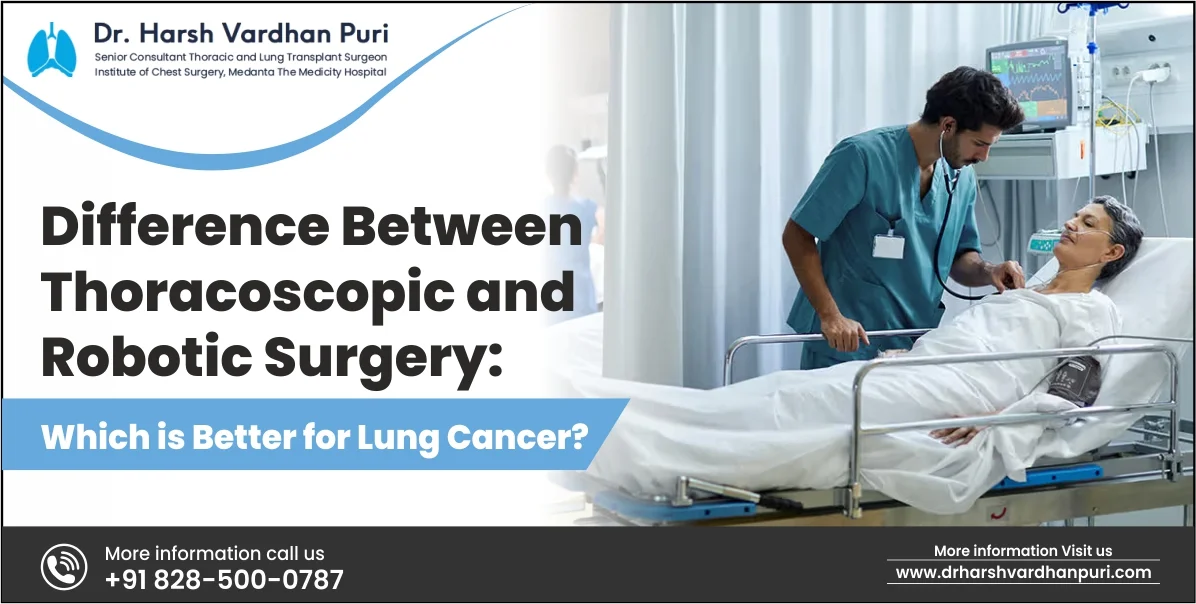CH Baktawar Singh Rd, Medicity, Islampur Colony, Sector 38, Gurugram, Haryana 122001
28 December, 2023

Making educated judgments about lung cancer treatment requires an understanding of the surgical alternatives. Advanced procedures are available in thoracoscopy and robotic surgery in gurgaon, each with advantages of their own. Determining the best option for treating lung cancer involves examining the variations between different techniques. Let’s examine these surgical techniques, comparing and contrasting their advantages and disadvantages to reveal which could provide the most favorable course of treatment for those with lung cancer.
Lung cancer can be treated minimally invasively via thoracic surgery, sometimes referred to as Video Assisted Thoracoscopy Surgery (VATS). This method entails making tiny incisions to introduce surgical equipment and a tiny camera. The thoracic surgeon in gurgaon is guided by the camera, which projects a clear image of the lungs onto a screen.
This technique reduces damage to the surrounding tissues, which speeds up healing and lessens pain after surgery. Because thoracic surgery is less intrusive and precise, it is a recommended treatment choice in some forms of lung cancer and provides patients with a positive prognosis.
VATS, or thoracic surgery, has many benefits for treating lung cancer. It entails
Robotic surgery is a cutting-edge method of treating lung cancer. It makes use of a unique apparatus that is managed by an exceptionally talented surgeon. small incisions are created during the process to insert robotic arms that have a camera and small instruments attached to them. The surgeon may then manipulate these arms from a console to get a better, enlarged 3D picture of the surgery site. Complex surgical duties and incredibly precise motions are made possible by this technology.
Compared to traditional open surgery, a robotic procedure for lung cancer has a number of benefits, including smaller incisions, less blood loss, less discomfort, and faster recovery. This advanced method is thought to be especially helpful in some cases of lung cancer when the benefits of surgery that are minimally invasive and accuracy are paramount.
Patients can benefit from a number of advantages that robotic surgery has over conventional techniques, including:
The goal of both robotic and thoracoscopy surgery as it relates to treating lung cancer is to offer less invasive substitutes for open surgery.
Small incisions are made during thoracoscopy surgery, referred to as VATS or video-assisted thoracoscopy surgery, to introduce a camera and surgical equipment. With this method, the surgeon can see the inside structures and carry out the operation while watching the pictures that the camera transmits.
However, robotic surgery makes use of an advanced system in which the surgeon operates robotic arms that are fitted with cameras and equipment from a console. With the use of technology, the surgeon can see in three dimensions and maneuver more precisely and deftly.
Both techniques vary from one another in their technical components, but they are both minimally invasive, with decreased loss of blood, less scarring and reduced time for recuperation than open surgery. In robotic surgery, the surgeon uses a console to operate the arms of a robot, whereas in thoracoscopy, the physician manipulates tools directly.
Because of being state-of-the-art equipment, surgery using robotics, promises greater accuracy and mobility as well as greater ease of use for the performing surgeon. Nevertheless, thoracoscopy surgery is still a popular and successful lung cancer treatment strategy, especially in situations when complex surgical procedures may be completed without requiring any robotic equipment.
The decision involving both of them eventually comes down to the particular patient’s health, the medical professional’s experience, as well as the healthcare facility’s capabilities.
There are a number of considerations to make when choosing robotic and thoracoscopy surgery as a treatment for lung cancer. These include the general state of the patient, the position, stage and size of the tumour, and the surgeon’s experience. The decision is influenced by additional important factors, such as the related expenses, the length of the recuperation, and possible adverse effects. Working together with an experienced medical team and carefully going over the benefits and drawbacks of every surgical technique is crucial to making sure the best strategy is chosen for the effective management of lung cancer.
Seeking advice from Dr. Harsh Vardhan Puri is essential when contemplating robotic or thoracoscopy surgery for lung cancer. Patients are empowered to make well-informed decisions because of his vast knowledge and competence in both operations. Offering thorough advice, Dr. Puri assesses each patient individually to identify the best surgical strategy. His knowledge guarantees individualized care, allowing patients to consider the advantages and make well-informed decisions on their course of therapy for lung cancer.
Category : Lung Cancer
Tags: